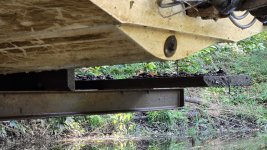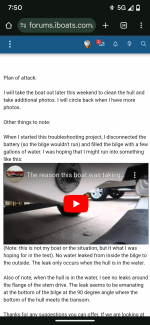93 Stingray 556
Cadet
- Joined
- Nov 16, 2020
- Messages
- 11
Hello all,
3.0L Mercruiser with Alpha One Gen 2 Sterndrive.
I recently noticed a leak in the bilge that I cannot figure out.
I've run the ear muff test to make sure it is not a bellows leak. The bellows around the shift cable, one around the U-joints, and one at the exhaust seem to all be in good order.
The leak is very slow and happens when the engine is off or on. It's slow but constant.... my bilge pump runs once every 5-8 minutes.
Here is a video of the leak.... For orientation purposes, I'm on the port side, facing starboard, looking toward the stern (transom). Notice how some of the small particles are moving away from the transom. I put my finger down there and I cannot feel incoming water, but the video appears to indicate otherwise.

 photos.app.goo.gl
photos.app.goo.gl
The picture below is what I assume is the approximate location of the leak. However, I am unable to see any significant damage. I ran aground approximately four years ago, but haven't noticed any leaks until now.

Plan of attack:
I will take the boat out later this weekend to clean the hull and take additional photos. I will circle back when I have more photos.
Other things to note:
When I started this troubleshooting project, I disconnected the battery (so the bilge wouldn't run) and filled the bilge with a few gallons of water. I was hoping that I might run into something like this:
(Note: this is not my boat or the situation, but it what I was hoping for in the test). No water leaked from inside the bilge to the outside. The leak only occurs when the hull is in the water.
Also of note, when the hull is in the water, I see no leaks around the flange of the stern drive. The leak seems to be emanating at the bottom of the bilge at the 90 degree angle where the bottom of the hull meets the transom.
Thanks for any suggestions you can offer. If we are looking at a fiberglass hull repair, how much does that run? Are there tools a shop can use to isolate the leak? The only thing that comes to mind for me is "magnafluxing an engine block." Clearly, there must be different detection tools for this material. Are there similar methods used in the fiberglass industry?
3.0L Mercruiser with Alpha One Gen 2 Sterndrive.
I recently noticed a leak in the bilge that I cannot figure out.
I've run the ear muff test to make sure it is not a bellows leak. The bellows around the shift cable, one around the U-joints, and one at the exhaust seem to all be in good order.
The leak is very slow and happens when the engine is off or on. It's slow but constant.... my bilge pump runs once every 5-8 minutes.
Here is a video of the leak.... For orientation purposes, I'm on the port side, facing starboard, looking toward the stern (transom). Notice how some of the small particles are moving away from the transom. I put my finger down there and I cannot feel incoming water, but the video appears to indicate otherwise.
New video by Paul Joseph Bennett, III
 photos.app.goo.gl
photos.app.goo.gl
The picture below is what I assume is the approximate location of the leak. However, I am unable to see any significant damage. I ran aground approximately four years ago, but haven't noticed any leaks until now.

Plan of attack:
I will take the boat out later this weekend to clean the hull and take additional photos. I will circle back when I have more photos.
Other things to note:
When I started this troubleshooting project, I disconnected the battery (so the bilge wouldn't run) and filled the bilge with a few gallons of water. I was hoping that I might run into something like this:
Also of note, when the hull is in the water, I see no leaks around the flange of the stern drive. The leak seems to be emanating at the bottom of the bilge at the 90 degree angle where the bottom of the hull meets the transom.
Thanks for any suggestions you can offer. If we are looking at a fiberglass hull repair, how much does that run? Are there tools a shop can use to isolate the leak? The only thing that comes to mind for me is "magnafluxing an engine block." Clearly, there must be different detection tools for this material. Are there similar methods used in the fiberglass industry?




















